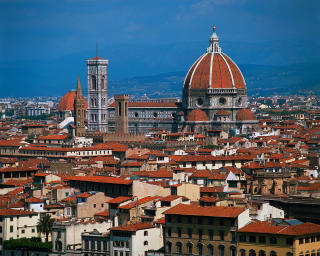
I’m currently reading an anthology entitled A Traveller’s Companion to Florence, which is a collection of the letters, diaries, and memoirs of travelers to and natives of Florence over the past several centuries. Some of the writers are well-known (Giovanni Boccaccio, Giorgio Vasari, D.H. Lawrence, Dylan Thomas, Robert Browning, Henry James, George Eliot, Oscar Wilde, Benvenuto Cellini, E.M. Forster, James Fenimore Cooper, Albert Camus, Charles Dickens, and Mark Twain), but most are just ordinary people who happened to record memorable moments in Florentine history.
 One of the contributors, painter and author Antoine Laurent Castellan, wrote a letter to a friend in 1820 in which he described the Piazza Santa Croce: “It’s length, and the beauty of the palaces which surround it, fit it for the theatres of the festivals which are given in it . . .”
One of the contributors, painter and author Antoine Laurent Castellan, wrote a letter to a friend in 1820 in which he described the Piazza Santa Croce: “It’s length, and the beauty of the palaces which surround it, fit it for the theatres of the festivals which are given in it . . .”And it just so happens that one of our faculty, Janet Black, lives in one of those very palaces. In fact, I believe that she lives in the most beautiful palace of all on the Piazza Santa Croce, a striking structure whose façade is completely frescoed. We had heard a bit about Janet’s apartment, but no amount of description could prepare us for the utter beauty and grandeur of this place. We all were able to see it first-hand this past Thursday when our faculty meeting took place there.
 You enter Janet’s building off the piazza through massive wooden doors; you then climb to the second floor to enter her vestibule. Let’s just put it this way: I think my entire apartment would fit in her vestibule! It’s gorgeous and has the feel of a museum; in fact, the walls are lined with stately antique seats and chairs, some of which are even outfitted with velvet ropes to prevent sitting.
You enter Janet’s building off the piazza through massive wooden doors; you then climb to the second floor to enter her vestibule. Let’s just put it this way: I think my entire apartment would fit in her vestibule! It’s gorgeous and has the feel of a museum; in fact, the walls are lined with stately antique seats and chairs, some of which are even outfitted with velvet ropes to prevent sitting.
 As we walked into the actual apartment, with its high ornate ceilings, we were literally left breathless. You see, her entire apartment is frescoed, as is evident in the photos. Now, to the average person this would be an amazing thing, but it’s even more meaningful to Janet as she is an art historian. How wonderful for her to be living in Florence in this frescoed palace!
As we walked into the actual apartment, with its high ornate ceilings, we were literally left breathless. You see, her entire apartment is frescoed, as is evident in the photos. Now, to the average person this would be an amazing thing, but it’s even more meaningful to Janet as she is an art historian. How wonderful for her to be living in Florence in this frescoed palace! In addition to the frescoed walls, her living room has a gorgeous marble fireplace and huge windows overlooking Santa Croce (Janet truly does have a “room with a view,” one that Miss Lavish and Lucy Honeychurch would have been more than satisfied with). Her bedroom, which also overlooks Santa Croce, is fit for a queen. The bed, as you can see, is huge and adorned with silk coverings, and the striped draping you see on the walls is actually painted on. Silk draperies cover the door that leads into a huge closet and adjoining bathroom. Her kitchen is also quite large and has two things that are extremely rare in Florence: a microwave and a clothes dryer. We were all slightly envious and, in fact, even felt a bit underdressed!

 We all had a marvelous time playing queen (and one king!) for the evening! Once again, the affair was potluck, with antipasta, salad, beef stew, pasta, and bread. Toni and I were thinking alike and both ended up bringing dessert. No problem there – after all, there’s always room for more than one dessert!
We all had a marvelous time playing queen (and one king!) for the evening! Once again, the affair was potluck, with antipasta, salad, beef stew, pasta, and bread. Toni and I were thinking alike and both ended up bringing dessert. No problem there – after all, there’s always room for more than one dessert! 
























































